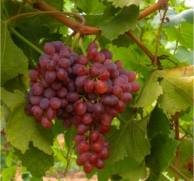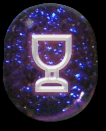Grapes
Grapes, the luscious and refreshing fruit of the Vine, possess certain medicinal properties and virtues which give them a proper place among Herbal Simples. The name Vine comes from viere, to twist, being applied with reference to the twining habits of the parent stock; as likewise to "with," and "withy."
Added Jul 20, 2010
| 7,064 Reads
The fruit consists of pulp, stones, and skin. Within the pulp is contained the grape sugar, which differs in some respects chemically from cane sugar, and which is taken up straightway into our circulation when eaten, without having to be changed slowly by the saliva, as is the case with cane sugar. Therefore it happens that the grape sugar warms and fattens speedily, with a quick repair of waste, when the strength and the structures are consumed by fever, Grapes then being most grateful to the sufferer. But they do not suit inflammatory subjects at other times, or gouty persons at any time, as well as cane sugar, which has to undergo slower chemical conversion before it furnishes heat and sustenance. And in this respect, grape sugar closely resembles the glucose, or sweet principle of honey. The fruit also contains a certain quantity of "fruit sugar," which is chemically identical with cane sugar; and, because of the special syrupy juice of its pulp, the Grape adapts itself to quick alcoholic fermentation. The important ingredients of Grapes are sugar (grape and fruit), gum, tannin, bitartrate of potash, sulphate of potash, tartrate of lime, magnesia, alum, iron, chlorides of potassium and sodium, tartaric, citric, racemic, and malic acids, some albumen, and azotized matters, with water. But the wine grower is glad to see his must deposit the greater part of these chemical ingredients in the "tartar," a product much disliked, and therefore named Sal Tartari, or Hell Salt; and Cremor Tartari, Hell Scum (Cream of Tartar). In Italy, the vine furnishes oil as well as wine, this being extracted from the grape stones, and reckoned superior to any other sort, whether for the table or for purposes of lighting. It has no odour, and burns without smoke. The stones also yield volatile essences, which are developed by crushing, and which give bouquet to the several wines, whilst the skin affords colouring matter and tannin, of more or less astringency. Grapes supply but little actual nutritious matter for building up the solid structures of the body; they act as gentle laxatives; though their stones, and the leaves of the vine, are astringent. These latter were formerly employed to stop bleedings, and when dried and powdered, for arresting dysentery in cattle. In Egypt the leaves are used, when young and tender, for enveloping balls of hashed meat, at good tables. The sap of the vine, named lacryma, "a tear," is an excellent application to weak eyes, and for specs of the cornea. The juice of the unripe fruit, which is verjuice (as well as that of the wild crabapple), was much esteemed by the ancients, and is still in good repute for applying to bruises and sprains. When taken in any quantity, Grapes act freely on the kidneys, and promote a flow of urine. The vegetable acids of the fruit become used up as such, and are neutralised in the system by combining with the earthy salts found therein, and they pass off in the urine as alkaline carbonates. With full-blooded, excitable persons, grapes in any quantity are apt to produce palpitation, and to quicken the circulation for a time. Also with persons of slow and feeble energies, having a languid digestion (and especially if predisposed to acid fermentation in the stomach), Grapes are apt to disagree. They send their glucose straightway into the circulation combined with acids found in the stomach, and create considerable distress of heartburn and dyspepsia. "Thus," says Dr. King Chambers, "is generated acidity of the stomach, parent of gout, and of all its hideous crew." Likewise wine, especially if sweet, new, or full-bodied, when taken by such persons at a meal, is absorbed but slowly by the stomach, and much of the sugar, with some alcohol, becomes converted by fermentation into acetic acid, which further causes the oily ingredients in the food which has been swallowed to turn rancid. "Things sweet to taste prove to digestion sour." But otherwise, with a person in good health, and not given to gout or rheumatism, Grapes are an excellent food for supplying warmth as combustion material, by their ready-made sugar; whilst the essential flavours of the fruit are cordial, and [239] whilst a surplus of the glucose serves to form fat for storage. What is known as the Grape-cure, is pursued in the Tyrol, in Bavaria, on the banks of the Rhine, and elsewhere—the sick person being ordered to eat from three to six pounds of grapes a day. But the relative proportions of the sugar and acids in the various kinds of grapes have important practical bearings on the results obtained, determining whether wholesome purgation shall follow, or whether tonic and fattening effects shall be produced. In the former case, sufferers from sluggish liver and torpid biliary functions, with passive local congestions, will benefit most by taking the grapes not fully ripe, and not completely sweet; whilst in the latter instance, those invalids will gain special help from ripe and sweet grapes, who require quick supplies of animal heat and support to resist rapid waste of tissue, as in chronic catarrh of the lungs, or mucous catarrh of the bowels. The most important constituent to be determined is the quantity of grape sugar, which varies according to the greater or less warmth of the climate. Tokay Grapes are the sweetest; next are those of southern France; then of Moselle, Bohemia, and Heidelberg; whilst the fruit of the Vine in Spain, Italy, and Madeira, is not commended for curative purposes. The Grapes are eaten three, four, or five times a day, during the promenade; those which are not sweet produce a diuretic and laxative effect; seeing, moreover, that their reaction is alkaline, the "cure" thereby is particularly suitable for persons troubled with gravel and acid gout. After losses of blood, and in allied states of exhaustion, the restorative powers of the grape-cure are often strikingly exhibited. Formerly, the German doctors kept their patients, when under this mode of treatment, almost entirely without other food. But it is now found that light, wholesome nourishment, properly chosen, and taken at regular times, even with some moderate allowance of Bordeaux wine, may be permitted in useful conjunction with the grapes. Children do not, as a rule, bear the grape-cure well. One sort of grape, the Bourdelas, or Verjus, being intensely sour when green, is never allowed to ripen, but its large berries are made to yield their acid liquor for use instead of vinegar or lemon juice, in sauces, drinks, and medicinal preparations. A vinegar poultice, applied cold, is an effectual remedy for sprains and bruises, and will arrest the progress of scrofulous enlargements of bones. It may be made with vinegar and oatmeal, or with the addition of bread crumb."—Pharmacopoeia Chirurgica, 1794. "Other fruits may please the palate equally well, but it is the proud prerogative of the kingly grape to minister also to the mind." This served to provide one of the earliest offerings to the Deity, seeing that "Bread and wine were brought forth to Abraham by Melchisedec, the Priest of the Most High God." The Vine (Vitis vinifera) was almost always to the front in the designs drawn by the ancients. Thus, miniatures and dainty little pictures were originally encircled with representations of its foliage, and we still name such small exquisite illustrations, "vignettes," from the French word, vigne. The large family of Muscat grapes get their distinctive title not because of any flavour of musk attached to them, but because the sweet berries are particularly attractive to flies (muscre), a reason which induced the Romans to name this variety, Vitis apiaria. "On attrape plus de mouches avec le miel qu' avec le vinaigre"— say the French. In Portugal, grape juice is boiled down with quinces into a sort of jam—the progenitor of all marmalades. The original grape vine is supposed to have been indigenous to the shores of the Caspian Sea. If eaten to excess, especially by young persons, grapes will make the tongue and the lining membrane of the mouth sore, just as honey often acts. For this reason, both grapes and honey do good to the affection known as thrush, with sore raw mouth, and tongue in ulcerative white patches, coming on as a derangement of the health.
VineThe fruit of the Vine (Vitis vinifera) has already been treated of here under the heading "Grapes," as employed medicinally whether for the purgation of the bilious--being then taken crude, and scarcely ripe,--or for imparting fat and bodily warmth in wasting disease by eating the luscious and richly-saccharine berries. It should be added that the fumes exhaled from the wine-presses whilst the juice is fermenting, prove highly beneficial as a restorative for weakly and delicate young persons (an example which might be followed perhaps at our home breweries). Consumptive patients are sent with this view to the Gironde, where the vapour from the wine vats is more stimulating and curative than in Burgundy. Young girls who suffer from atrophy are first made to reside for some hours daily in the sheds when the wine pressing is going forward. After a while, as they become less weak, they are directed to jump into the wine press, where, with the vintagers and labourers they skip about and inhale the fumes of the fermenting juice, until they sometimes become intoxicated, and even senseless. This effect passes off after one or two trials, and the girls return to their labour with renewed strength and heightened colour, hopeful, joyous, and robust. The vats of the famous Chateau d'yquem are the most celebrated of all for the wondrous cures they have effected even in cases considered past human aid.
* You can download a modern version of the Grape Cure here free.
Added Jul 20, 2010
| 7,064 Reads
Share The Magic ...
The GoE MONEY!!! Course - A Course In Real MONEY MAGIC!
|





















